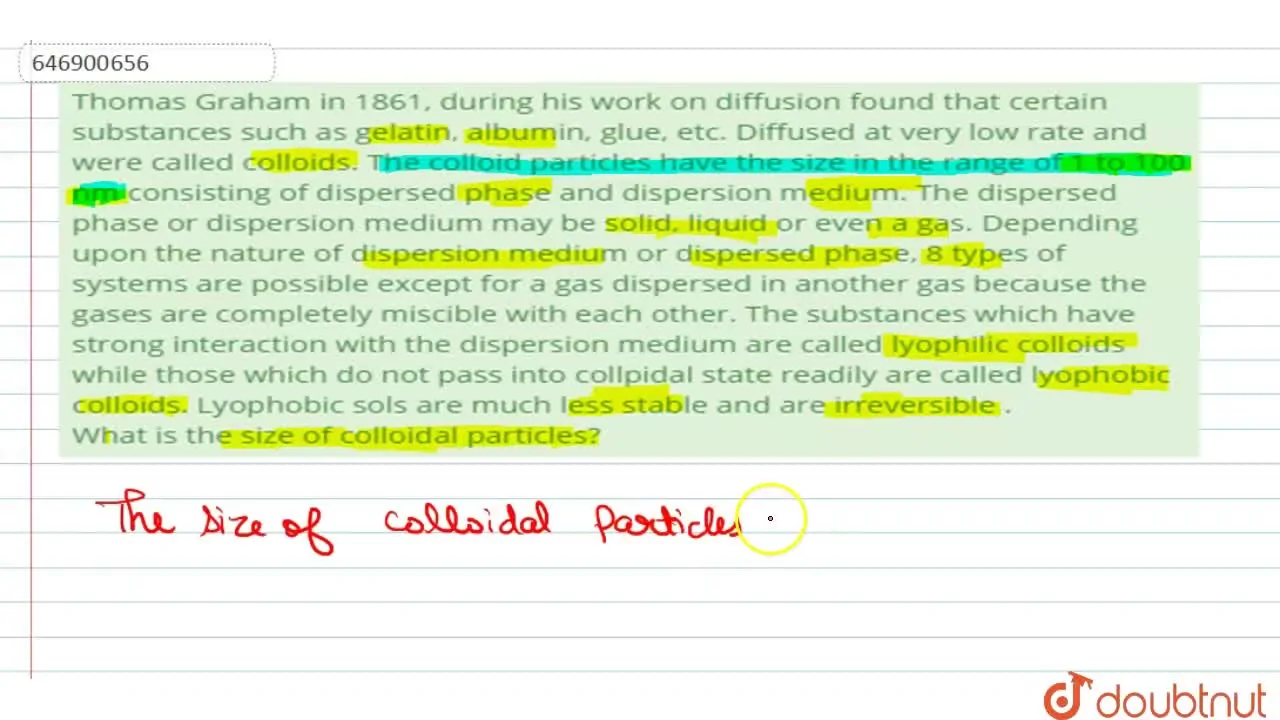Thomas Graham in 1861, during his work on diffusion found that certain substances such as gelatin, albumin, glue, etc. Diffused at very low rate and were called colloids. The colloid particles have the size in the range of 1 to 100 nm consisting of dispersed phase and dispersion medium. The dispersed phase or dispersion medium may be solid, liquid or even a gas. Depending upon the nature of dispersion medium or dispersed phase, 8 types of systems are possible except for a gas dispersed in another gas because the gases are completely miscible with each other. The substances which have strong interaction with the dispersion medium are called lyophilic colloids while those which do not pass into collpidal state readily are called lyophobic colloids. Lyophobic sols are much less stable and are irreversible .
What is the size of colloidal particles? Solution in Punjabi
Step by step video & image solution for Thomas Graham in 1861, during his work on diffusion found that certain substances such as gelatin, albumin, glue, etc. Diffused at very low rate and were called colloids. The colloid particles have the size in the range of 1 to 100 nm consisting of dispersed phase and dispersion medium. The dispersed phase or dispersion medium may be solid, liquid or even a gas. Depending upon the nature of dispersion medium or dispersed phase, 8 types of systems are possible except for a gas dispersed in another gas because the gases are completely miscible with each other. The substances which have strong interaction with the dispersion medium are called lyophilic colloids while those which do not pass into collpidal state readily are called lyophobic colloids. Lyophobic sols are much less stable and are irreversible . What is the size of colloidal particles? by Chemistry experts to help you in doubts & scoring excellent marks in Class 12 exams.
Related Playlists
- BOOK - ACCURATE PUBLICATIONCHAPTER - MODEL TEST PAPER-1 EXERCISE - SECTION-A (True/False )5videos
MODEL TEST PAPER-1
- BOOK - ACCURATE PUBLICATIONCHAPTER - MODEL TEST PAPER-1 EXERCISE - SECTION-B (SHORT ANSWER)16videos
MODEL TEST PAPER-1
- BOOK - ACCURATE PUBLICATIONCHAPTER - MODEL TEST PAPER-1 EXERCISE - SECTION-D (LONG ANSWER QUESTIONS) (TYPE II)11videos
MODEL TEST PAPER-1
- BOOK - ACCURATE PUBLICATIONCHAPTER - IMPORTANT NAMING REACTIONEXERCISE - DISTINGUISH TEST5videos
IMPORTANT NAMING REACTION
- BOOK - ACCURATE PUBLICATIONCHAPTER - MODEL TEST PAPER-10EXERCISE - SECTION-D (LONG ANSWER QUESTIONS) (TYPE II)15videos
MODEL TEST PAPER-10
Similar Questions
Secondary amines don't evolve N2 with nitrous acid. Explain
00:59View SolutionWhy transition metal have tendency to form many complexes ?
01:48View SolutionExplain the following reactions:
Balz Schiemann reaction.View SolutionDiscuss iodoform test. How will you distinguish between propane-1-ol and Propane-2-ol with this test ?
View SolutionGive the following reactions:
Fitting reaction02:51View SolutionWhen dispersed phase is liquid and dispersion medium is gas, then the colloidal system is called
View SolutionIf the dispersed phase is a solid and thye dispersion medium is a liquid, then colloidal system is known as a/an.
01:51View SolutionA colloidal solution of a solid as dispersed phase and liquid as dispersion medium is known as :
01:59View SolutionIf the dispersed phase is a liquid and the dispersion medium is a solid, the colloid is known as:-
01:35View SolutionThe dispersion medium is a liquid and the dispersed phase is a gas. Name the colloid
01:11View SolutionName the colloid in which the dispersed phase is solid and dispersion medium is liquid
01:15View Solutionयदि परिक्षिप्त प्रावस्था (Dispersed phase) एक द्रव है तथा परिक्षेपण माध्यम एक ठोस है, तब कोलॉइड कहलाता है।
01:12View Solutionजब परिक्षिप्त प्रावस्था द्रव होती है और परिक्षेपण माध्यम गैस होती है तो कोलॉइडी तंत्र कहलाता है ।
View SolutionWhen dispersed phase is solid and dispersion medium is gas, the colloidal system is
View SolutionWhen dispersed phase is liquid and dispersion medium is a solid, the colloid is known as
02:57View SolutionWhen dispersed phase is solid and dispersion medium is gas, the colloidal system is
02:57View Solution


